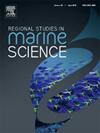调节韩国沿海水域春季浮游植物初级生产的关键因素
IF 2.4
4区 环境科学与生态学
Q3 ECOLOGY
引用次数: 0
摘要
浮游植物初级生产是海洋生态系统的基础,是生态金字塔的基础。然而,目前关于韩国沿海水域初级生产的资料很少。为了解决这一知识差距,在2022年5月和2023年5月使用13C稳定同位素示踪剂测量了初级产量。平均每天在观察期间初级生产403.5 ±317.8 mg C m⁻²d⁻¹ 黄海沿海(y), 722.0 ±464.6 mg C m⁻²d⁻¹ 沿海东海(ES)和739.8 ±594.1 mg C m⁻²d⁻¹ 沿海南海(SS),分别。在沿海YS中,包括锦江河口在内的北部站点的初级产量显著高于南部站点(Mann-Whitney U检验,p <; 0.05),其中W44站点在南部站点中表现出异常高的值。同样,在沿海SS中也观察到显著的区域差异,其中东部地区的初级产量大约是西部地区的6倍(Mann-Whitney U检验,p <; 0.05)。主成分分析(PCA)和多元线性回归(MLR)结果表明,叶绿素a浓度和光照强度是调节各区域初级生产的关键因子。这些发现突出了这些因素在形成生产力模式方面的关键作用,并强调了对初级生产进行持续监测的必要性,以进一步提高对韩国沿海生态系统的了解。本文章由计算机程序翻译,如有差异,请以英文原文为准。
Key factors regulating springtime phytoplankton primary production in the coastal waters of South Korea
Phytoplankton primary production is fundamental to marine ecosystems, serving as the foundation of the ecological pyramid. However, little information is currently available on the primary production in coastal waters of South Korea. To address this knowledge gap, primary production was measured using a 13C stable isotope tracer in May 2022 and 2023. The mean daily primary production during the observation period were 403.5 ± 317.8 mg C m⁻² d⁻¹ in the coastal Yellow Sea (YS), 722.0 ± 464.6 mg C m⁻² d⁻¹ in the coastal East Sea (ES), and 739.8 ± 594.1 mg C m⁻² d⁻¹ in the coastal South Sea (SS), respectively. In the coastal YS, northern stations, including the Geum River estuary, showed significantly higher primary production than southern stations (Mann-Whitney U test, p < 0.05), with station W44 exhibiting an exceptionally high value among the southern stations. Similarly, notable regional variation was observed in the coastal SS, where the primary production in the eastern region was approximately 6-fold higher then the western region (Mann-Whitney U test, p < 0.05). Principal component analysis (PCA) and multiple linear regression (MLR) identified chlorophyll a concentration and light intensity as the key factors regulating the primary production across the regions. These findings highlight the critical role of these factors in shaping productivity patterns and underscore the need for ongoing monitoring of primary production to further enhance understanding of coastal ecosystems in South Korea.
求助全文
通过发布文献求助,成功后即可免费获取论文全文。
去求助
来源期刊

Regional Studies in Marine Science
Agricultural and Biological Sciences-Ecology, Evolution, Behavior and Systematics
CiteScore
3.90
自引率
4.80%
发文量
336
审稿时长
69 days
期刊介绍:
REGIONAL STUDIES IN MARINE SCIENCE will publish scientifically sound papers on regional aspects of maritime and marine resources in estuaries, coastal zones, continental shelf, the seas and oceans.
 求助内容:
求助内容: 应助结果提醒方式:
应助结果提醒方式:


